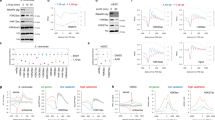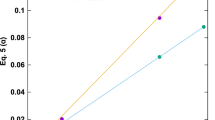Abstract
The expression patterns of eukaryotic genomes are controlled by their chromatin structure, consisting of nucleosome subunits in which DNA of approximately 146 bp is wrapped around a core of 8 histone molecules1. Post-translational histone modifications play an essential role in modifying chromatin structure2. Here we apply a combination of SAGE3 and chromatin immunoprecipitation (ChIP) protocols to determine the distribution of hyperacetylated histones H3 and H4 in the Saccharomyces cerevisiae genome. We call this approach genome-wide mapping technique (GMAT). Using GMAT, we find that the highest acetylation levels are detected in the 5′ end of a gene's coding region, but not in the promoter. Furthermore, we show that the histone acetyltransferase, GCN5p, regulates H3 acetylation in the promoter and 5′ end of the coding regions. These findings indicate that GMAT should find valuable applications in mapping target sites of chromatin-modifying enzymes.
This is a preview of subscription content, access via your institution
Access options
Subscribe to this journal
Receive 12 print issues and online access
$209.00 per year
only $17.42 per issue
Buy this article
- Purchase on Springer Link
- Instant access to full article PDF
Prices may be subject to local taxes which are calculated during checkout



Similar content being viewed by others
References
Kornberg, R.D. & Lorch, Y. Twenty-five years of the nucleosome, fundamental particle of the eukaryote chromosome. Cell 98, 285–294 (1999).
Felsenfeld, G. & Groudine, M. Controlling the double helix. Nature 421, 448–453 (2003).
Velculescu, V.E., Zhang, L., Vogelstein, B. & Kinzler, K.W. Serial analysis of gene expression. Science 270, 484–487 (1995).
Velculescu, V.E. et al. Characterization of the yeast transcriptome. Cell 88, 243–251 (1997).
Saha, S. et al. Using the transcriptome to annotate the genome. Nat. Biotechnol. 20, 508–512 (2002).
Braunstein, M., Rose, A.B., Holmes, S.G., Allis, C.D. & Broach, J.R. Transcriptional silencing in yeast is associated with reduced nucleosome acetylation. Genes Dev. 7, 592–604 (1993).
Rundlett, S.E., Carmen, A.A., Suka, N., Turner, B.M. & Grunstein, M. Transcriptional repression by UME6 involves deacetylation of lysine 5 of histone H4 by RPD3. Nature 392, 831–835 (1998).
Davie, J.R., Saunders, C.A., Walsh, J.M. & Weber, S.C. Histone modifications in the yeast S. cerevisiae. Nucleic Acids Res. 9, 3205–3216 (1981).
Vogelauer, M., Wu, J., Suka, N. & Grunstein, M. Global histone acetylation and deacetylation in yeast. Nature 408, 495–498 (2000).
Grunstein, M. Yeast heterochromatin: regulation of its assembly and inheritance by histones. Cell 93, 325–328 (1998).
DuBois, M.L., Diede, S.J., Stellwagen, A.E. & Gottschling, D.E. All things must end: telomere dynamics in yeast. Cold Spring Harb. Symp. Quant. Biol. 65, 281–296 (2000).
Chan, C.S. & Tye, B.K. Organization of DNA sequences and replication origins at yeast telomeres. Cell 33, 563–573 (1983).
Pryde, F.E. & Louis, E.J. Limitations of silencing at native yeast telomeres. EMBO J. 18, 2538–2550 (1999).
Boeger, H., Griesenbeck, J., Strattan, J.S. & Kornberg, R.D. Nucleosomes unfold completely at a transcriptionally active promoter. Mol. Cell 11, 1587–1598 (2003).
Reinke, H. & Horz, W. Histones are first hyperacetylated and then lose contact with the activated PHO5 promoter. Mol. Cell 11, 1599–1607 (2003).
Brownell, J.E. et al. Tetrahymena histone acetyltransferase A: a homolog to yeast Gcn5p linking histone acetylation to gene activation. Cell 84, 843–851 (1996).
Grant, P.A. et al. Yeast Gcn5 functions in two multisubunit complexes to acetylate nucleosomal histones: characterization of an Ada complex and the SAGA (Spt/Ada) complex. Genes Dev. 11, 1640–1650 (1997).
Kuo, M.H. et al. Transcription-linked acetylation by Gcn5p of histones H3 and H4 at specific lysines. Nature 383, 269–272 (1996).
Horak, C.E. & Snyder, M. ChIP-chip: a genomic approach for identifying transcription factor binding sites. Methods Enzymol. 350, 469–483 (2002).
Wan, M., Zhao, K., Lee, S.S. & Francke, U. MECP2 truncating mutations cause histone H4 hyperacetylation in Rett syndrome. Hum. Mol. Genet. 10, 1085–1092 (2001).
Suka, N., Suka, Y., Carmen, A.A., Wu, J. & Grunstein, M. Highly specific antibodies determine histone acetylation site usage in yeast heterochromatin and euchromatin. Mol. Cell 8, 473–479 (2001).
Mueller, P.R. & Wold, B. In vivo footprinting of a muscle specific enhancer by ligation mediated PCR. Science 246, 780–786 (1989).
Acknowledgements
We thank David Clark, Gerald Crabtree, Warren Leonard and Carl Wu for their comments on the manuscript. The wild-type yeast W303 was provided by David Clark and Carl Wu. The GCN5-deleted yeast strain was provided by Rohinton Kamakaka. The flag-H2B yeast strain was provided by Zu-wen Sun and David Allis. The Long-SAGE software was provided by Kenneth W. Kinzler. The work was supported by National Heart, Lung, and Blood Institute (K.Z.)/ National Library of Medicine, National Center for Biotechnology Information (D.L.).
Author information
Authors and Affiliations
Corresponding author
Ethics declarations
Competing interests
The authors declare no competing financial interests.
Supplementary information
Supplementary Fig. 1
Anti-diacetylated K9/K14 histone H3 and anti-tetraacetylated histone H4 antibodies specifically recognized acetylated histones in yeast chromatin. (PDF 175 kb)
Supplementary Fig. 2
AcH3 distribution on all chromosomes. (PDF 423 kb)
Supplementary Fig. 3
AcH4 distribution on all chromosomes. (PDF 419 kb)
Supplementary Fig. 4
Inducible genes are marked by acetylation under non-inducible conditions. (PDF 218 kb)
Supplementary Fig. 5
AcH4 distribution on all telomeres. (PDF 227 kb)
Supplementary Fig. 6
Telomeric Position Effect (TPE) is inversely correlated with the level of histone hyperacetylation. (PDF 20 kb)
Supplementary Fig. 7
Distribution of tags in the promoter region and along the open reading frames for histone H4 of wild type (a) and GCN5-deleted (b) yeast (PDF 116 kb)
Supplementary Table 1
Tag Density (PDF 54 kb)
Rights and permissions
About this article
Cite this article
Roh, Ty., Ngau, W., Cui, K. et al. High-resolution genome-wide mapping of histone modifications. Nat Biotechnol 22, 1013–1016 (2004). https://doi.org/10.1038/nbt990
Received:
Accepted:
Published:
Issue Date:
DOI: https://doi.org/10.1038/nbt990
This article is cited by
-
Measurement of differential chromatin interactions with absolute quantification of architecture (AQuA-HiChIP)
Nature Protocols (2020)
-
Profiling chromatin states using single-cell itChIP-seq
Nature Cell Biology (2019)
-
Investigating the genetic and epigenetic basis of big biological questions with the parthenogenetic marbled crayfish: A review and perspectives
Journal of Biosciences (2018)
-
Histone Modification Patterns and Their Responses to Environment
Current Environmental Health Reports (2014)
-
Detection of histone modifications at specific gene loci in single cells in histological sections
Nature Methods (2013)



